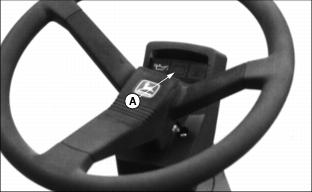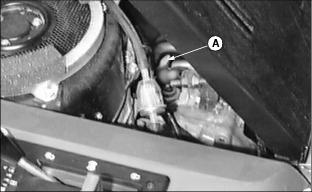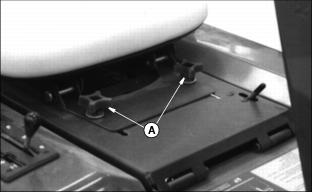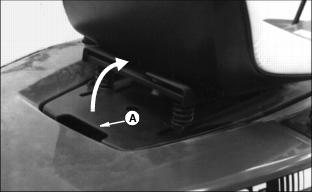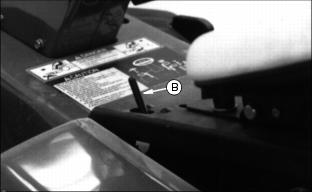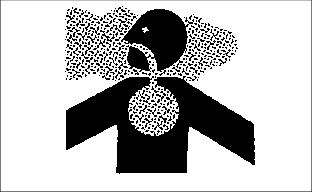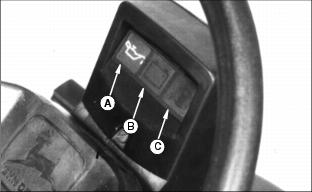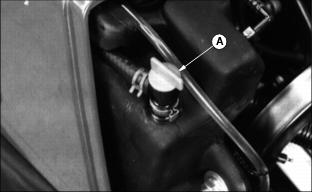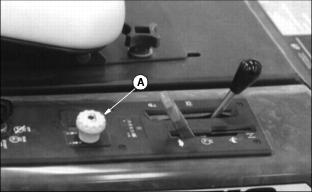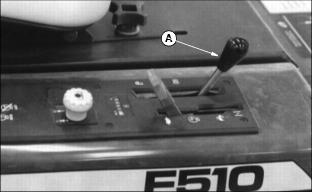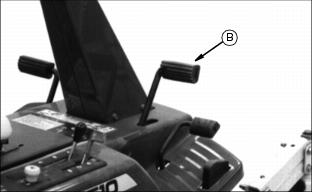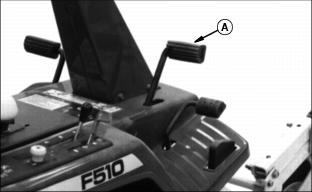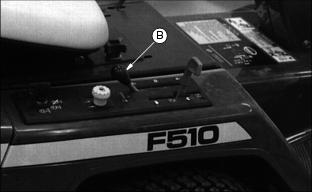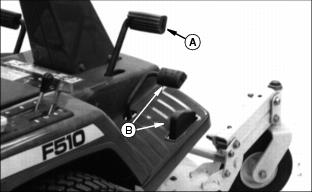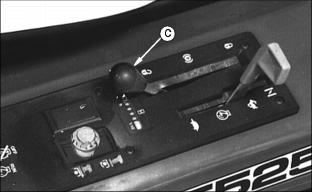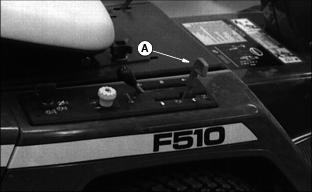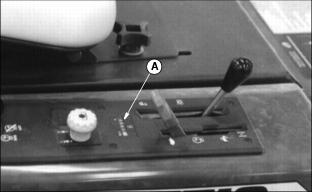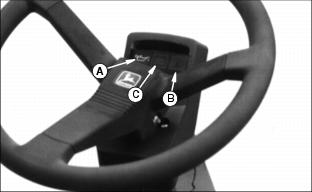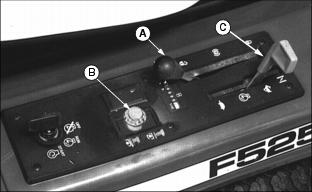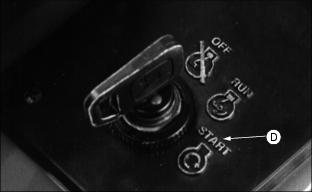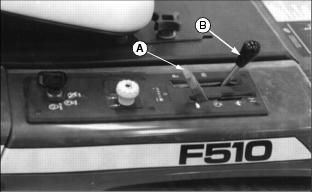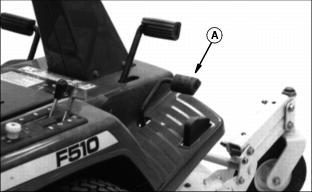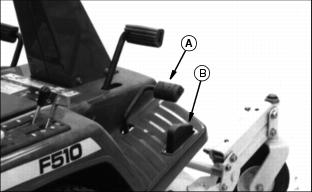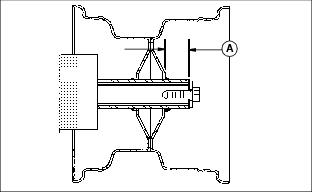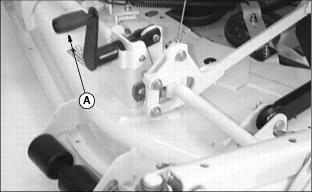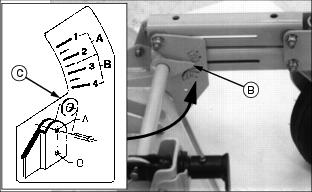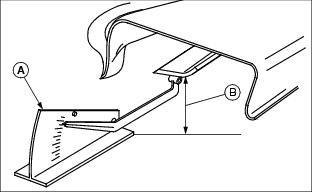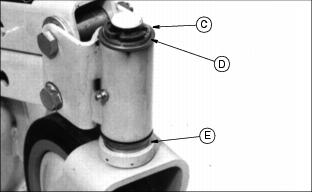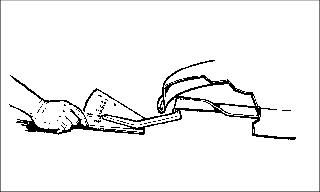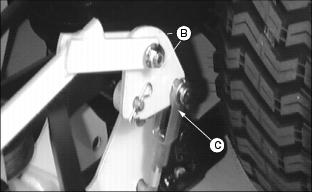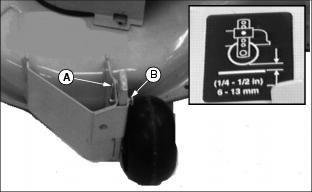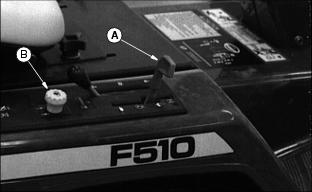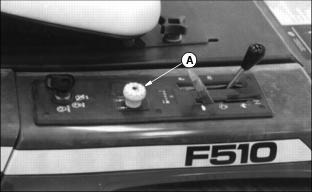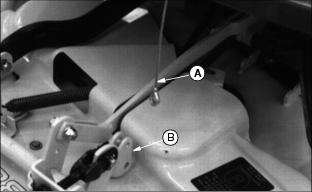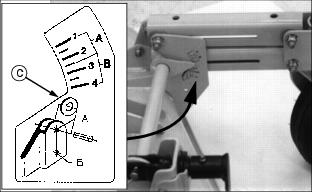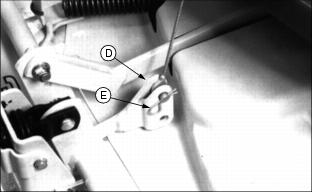Introduction
Product Identification
Safety
Operating
Avoid Damage To Plastic And Painted Surfaces
Mounting and Dismounting Front Mower
Using The Brake Pedal As Emergency Stop
Moving Front Mower With Engine Off (Free-Wheeling Lever)
Adjusting Mower Level (Side-To-Side)
Adjusting Mower Level (Front-To-Rear)
Adjusting Weight Transfer Cable
Replacement Parts
Service Intervals
Service Lubrication
Service Engine
Service Transmission
Service Steering & Brakes
Service Mower
Service Electrical
Service Miscellaneous
Troubleshooting
Storage
Assembly
Specifications
Warranty
John Deere Quality Statement
Service Record
CopyrightŠ Deere & Company

Operating
Daily Operating Checklist
o Check engine/transmission oil level.
o Remove grass and debris from machine.
o Check area below machine for leaks.
Avoid Damage To Plastic And Painted Surfaces
ˇ DO NOT wipe plastic parts unless rinsed first.
ˇ Insect repellent spray may damage plastic and painted surfaces. Do not spray insect repellent near machine.
ˇ Be careful not to spill fuel on machine. Fuel may damage surface. Wipe up spilled fuel immediately.
Operator Station Controls
Mounting and Dismounting Front Mower
1. Get on Front Mower from the left side only.
2. Step on left foot platform (A) to get on Front Mower.
Adjusting Seat
1. Sit on operator's seat. Loosen knobs (A) located in front of seat on seat platform.
2. Slide seat to desired position. Tighten knobs.
Using Seat Release Lever
ˇ Stand on left side of Front Mower. ˇ Put right hand only on the cut-out hand-hold area on rear of seat base. |
1. To raise seat, lift rear of seat base at the cut-out hand-hold area (A) to latch seat in the first or second position.
When you lower the seat, be careful not to pinch your hand between seat platform and Front Mower frame. |
2. To lower seat, lift rear of seat slightly at the cut-out hand-hold area and push and hold lever (B) forward.
3. Lower seat slowly to avoid pinching your hand between seat platform and Front Mower frame.
Testing Safety Systems
Use the following checkout procedure to check for normal operation of machine.
If there is a malfunction during one of these procedures, Do not operate machine. See your John Deere dealer for service.
Perform these tests in a clear open area. Keep bystanders away.
Checking Indicator Lights
NOTE: Indicator light (C) will come on only when fuel level is low.
2. Check to see if indicator lights (A) and (B) come on.
Testing Brake Switch
1. Unlock park brake and release brake pedal.
2. Turn key to START position.
Testing PTO Switch
1. Depress brake pedal, or lock park brake.
2. Put PTO switch lever in ON position.
3. Turn key to START position.
Testing Seat Switch
Test One
1. Start engine. Run engine at low or half speed.
2. Unlock park brake and release brake pedal.
3. Put PTO switch lever in ON position.
4. Raise up off seat. Do not get off tractor.
NOTE: PTO will remain engaged.
Test Two
4. Raise up off seat. Do not get off tractor.
Test Three
4. Raise up off seat. Do not get off tractor.
Using Fuel Shut-Off Valve
1. Turn knob (A) in line with fuel line to open fuel shutoff valve.
2. Turn knob (A) sideways to close the fuel shutoff valve.
Using Key Switch
1. Turn key (A) straight ahead to the off position.
2. Turn key to the run position: Two indicator lights should go on.
3. Turn key to the start position to start the engine.
Using PTO Switch Knob
1. Pull knob (A) up to engage PTO.
2. Push knob (A) down to disengage PTO.
Using The Park Brake
Locking the Park Brake
1. Move the park brake lock lever (A) forward to the locked position.
2. Push the brake pedal (B) down to lock the brake.
Unlocking the Park Brake
1. Push the brake pedal (A) down.
2. Move the park brake lever (B) to the rear to the unlocked position.
Using The Brake Pedal As Emergency Stop
1. Push brake pedal (A) down. When you push the pedal down, travel pedals (B) will return to the neutral position and PTO will stop.
2. Hold pedal down or lock the park brake before starting the engine.
Moving Front Mower With Engine Off (Free-Wheeling Lever)
1. Lift seat platform to the second position.
2. Push free-wheeling lever (A) forward to hold release button (B) down.
3. Lower seat before you move the Front Mower.
5. Move Front Mower to the desired location.
Using Weight Transfer Pedal
The weight transfer cable on the mower must be changed to different positions, depending on cut height range, see label (B) on mower deck.
NOTE: Use pedal only when you need more uphill traction. Do not use in downhill travel.
1. Push weight transfer pedal (A) down to help improve uphill traction.
2. Reference the label (B) by the mower deck height indicator and connect weight transfer cable to the appropriate hole.
Using The Throttle Lever
1. Push the throttle lever (A) forward to the fast position. Operate the mower with lever in this position.
2. Move lever to the rear to the slow position. Do not run engine at slow throttle any longer than necessary.
3. Move lever all the way forward to the choke position to start the engine.
4. Pull lever back as the engine warms.
Using The Hour Meter
The hour meter (A) records the number of hours the engine has run.
1. Check the hour meter to determine when the Front Mower needs service.
Using Indicator Lights
IMPORTANT: Avoid damage! If indicator lights red when engine is running, stop engine immediately, or engine may be seriously damaged from lack of lubrication. |
A-Oil Pressure Indicator Light
ˇ Red indicator light means oil is low and/or oil pressure is low.
ˇ Indicator should light when you turn key switch to the on position.
ˇ Light should go out when engine starts.
B-Low Fuel Indicator Light
ˇ Yellow indicator light means fuel is low. Engine will run for only a short time after the light comes on.
ˇ Light should go out when sufficient fuel is added.
C-Battery Indicator Light
ˇ Yellow indicator light means battery is not getting enough charge from the alternator.
ˇ Indicator should light when you turn key switch to the run position.
ˇ Light should go out when engine starts.
Starting The Engine
NOTE: Engine will not start unless PTO is disengaged, park brake is locked or brake pedal is pushed down.
3. Move throttle lever (C) all the way up to the choke position.
IMPORTANT: Avoid damage! Starter may be damaged if starter is operated for more than 20 seconds at a time: ˇ Wait two minutes before trying again if engine does not start. |
4. Turn key to start position (D) for no longer than five seconds.
5. Release key to run position when engine starts.
ˇ If engine does not start, wait 10 seconds.
ˇ Turn key to start position again for no longer than five seconds.
ˇ Repeat procedure if necessary.
IMPORTANT: Avoid damage! To help prevent engine from overheating or carbon build-up, do not slow-idle engine any longer than necessary. |
6. Let engine run at half-speed position for a couple of minutes to warm-up before operating machine.
Stopping Engine
1. Move throttle lever (A) to slow position. Let engine run at low throttle a few seconds.
Using Travel Pedals
To travel forward
NOTE: Rest your heel on the foot platform for stability.
1. Push pedal (A) down to travel forward.
2. Push pedal further down to travel faster.
3. Release pedal. It will return to the neutral position and stop the Front Mower.
To travel in reverse
1. Pivot foot from forward travel pedal (A) to reverse travel pedal (B).
2. Push pedal down to travel in reverse.
3. Push pedal further down to travel faster.
4. Release pedal. It will return to the neutral position and stop the Front Mower.
Changing Wheel Position
NOTE: Some Front Mowers were shipped from the factory with the drive wheels in the narrow position. When operating the Front Mower with tire chains and wheel weights, the drive wheels must be placed in the wide position.
When operating the Front Mower with tire chains and wheel weights you need to put the drive wheels in the wide position.
Check drive wheels for wide position:
ˇ Remove plastic cap from axle.
ˇ Measure hub. Wheel in wide position will measure distance (A), approximately 25 mm (1 in.).
ˇ If necessary, remove drive wheel, turn it around and install in the wide position.
Adjusting Cutting Height
NOTE: Because mowing conditions vary, along with the condition of your mower, actual cutting height may be different than shown by pointer (B). You may have to measure height of grass in several places to learn actual cutting height.
Cutting height can be adjusted from 25-102 mm (1-4 in.).
Turn crank (A) clockwise to raise the mower and counterclockwise to lower the mower.
NOTE: When changing mower deck height, it might also be necessary to change the location of the Weight Transfer Cable. Check label (C) when changing mower deck height. This will ensure proper operation of the Weight Transfer System.
Pointer (B) shows cutting height.
Adjusting Mower Level (Side-To-Side)
1. Park the machine safely. (See Park Safely in the Safety section.)
3. Use crank to put mower at desired cutting height.
4. Raise rear gage wheel to the lowest cut position (off ground).
5. Turn blades to allow access from discharge chute.
Picture Note: A convenient leveling gauge (AM130907) is available from your John Deere dealer.
6. Measure from each outside blade tip (A) to the level surface. The difference between measurements must not be more than 3mm (1/8 in.).
7. Raise and block one side of mower about 150 mm (6 in.).
10. Move top washer (D) to bottom position (E) to raise one side of mower.
ˇ Move washer from bottom to top to lower one side of mower.
Adjusting Mower Level (Front-To-Rear)
1. Park the machine safely. (See Park Safely in the Safety section.)
3. Turn blades so blade tips point straight forward.
NOTE: Use a short ruler or leveling gauge for measuring. Order gauge from your John Deere dealer.
Picture Note: A convenient leveling gauge (AM130907) is available from your John Deere dealer.
4. Measure the front and rear of each blade tip to the level surface. The front blade tips must be 3-6 mm (1/8-1/4 in.) lower than rear blade tips.
5. Remove spring locking pin and drilled pin (B) from yoke.
7. Install drilled pin and spring locking pin.
Adjusting Gauge Wheel
Picture Note: 48-in. - Use decal on mower as a reference.
1. Park the machine safely. (See Park Safely in the Safety section.)
3. Remove spring locking pin (A) and drilled pin (B).
4. Adjust wheel so it is 6 mm (1/4 in.) above hard surface.
Using The Mower
IMPORTANT: Avoid damage! The PTO clutch may be damaged if the mower is engaged with the engine is at a fast throttle speed. |
To engage the mower:
NOTE: When mower is new or engine is not fully warmed up, you may need faster engine speed.
1. Move throttle lever (A) to one-third to one-half throttle.
3. Move throttle lever to full throttle to operate mower.
Disengaging the mower:
Adjusting Weight Transfer Cable
1. Connect the weight transfer cable (A) to the mower deck attaching bracket (B). Use label (C) to determine which hole to use.
Reference the label (C) by the mower deck height indicator and connect weight transfer cable to the appropriate hole.
ˇ Use upper hole "A" for cutting heights between 25-64 mm (1 to 2-1/2 in.).
ˇ Use lower hole "B" for cutting heights between 64-101 mm (2-1/2 to 4 in.).
2. Attach cable with drilled pin (D) in correct hole for cutting height and install spring locking pin (E).
Mowing Tips
The following recommendations will produce the best lawn cut quality and appearance:
ˇ Keep mower blades sharp. Dull blades will tear grass; tips of grass will then turn brown.
ˇ Cutting grass too short may kill grass and let weeds grow easily.
ˇ Adjust cutting height to remove only 1/3 of the grass at a time.
ˇ Mow grass often. Short grass clippings will decay quickly.
ˇ Mow with engine at full throttle.
ˇ Adjust travel speed to match mowing conditions:
ˇ Travel at slow speed when you mow thick, tall grass, make sharp turns or trim around objects.
ˇ Travel at moderate speed when you mow thin grass.
ˇ Use a different mowing pattern each time you mow. Overlap mowing paths 50 to 100 mm (2 to 4 in.).
ˇ Drive over ridges and through shallow ditches straight-on, not at an angle.
ˇ A thick layer of mulched leave can prevent sunlight from getting to grass and smother it. Taller grass heights allow mulched leaves to dispense easier in lawn. Mulch leaves several times if needed.
ˇ Use a thatcher in late spring or summer to pull up dead grass and aerate ground.
Transporting Machine
Use a heavy-duty trailer to transport your machine.
Drive machine forward onto a trailer. Lower any attachments to trailer deck.
Lock park brake. Remove the key. Block the wheels.
Fasten Front Mower to trailer with heavy-duty straps, chains, or cables. Both front and rear straps must be directed down and outward from machine.
Trailer must have signs and lights required by law.
Towing Loads
Use drawbar to pull light trailers, carts, or other light attachments.
Do not tow more than 225 kg (496 lb) gross weight.



